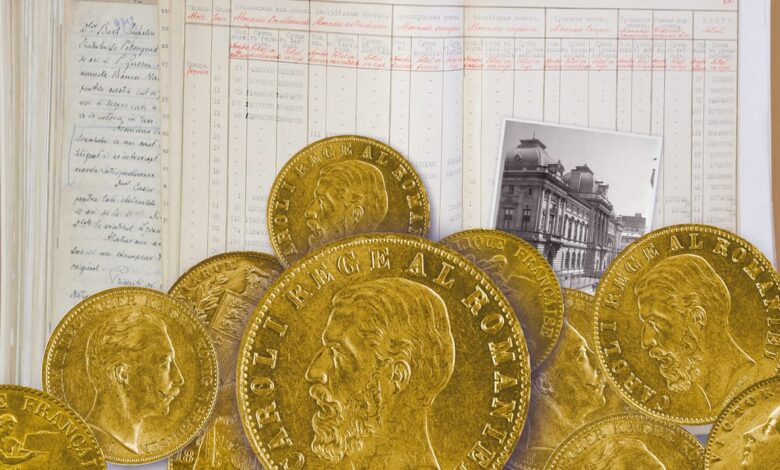The gold treasure of National Bank of Romania that was sent to Moscow – POLITICO

The troubled story of the evacuation of the National Bank of Romania treasure to Moscow began during the First World War. Romania entered the war in August 1916, joining the ‘entente’ of France, United Kingdom and Russia. After the initial victories, Romania’s situation became increasingly challenging, as it fought a two-front war against the central powers: with Germany and Austria-Hungary in the north-west and with Germany, Bulgaria and the Ottoman Empire in the south, along the Danube. Thus, in December 1916, the Romanian army was forced to retreat to Moldavia and to cede two-thirds of the country’s territory, including Bucharest, its capital city. All central institutions — the royal house of Romania, the parliament, the government, the National Bank of Romania — relocated in Iași (Jassy), to the east of Romania. The risk of the entire country being occupied by the armies of the central powers led the government of Romania to send the National Bank of Romania treasure to Moscow. The decision took into account the fact that Russia was the sole ally with which Romania shared a common border, and that Romania’s royal family had strong family ties with Russia’s imperial family: Queen Marie of Romania was Tsar Nicholas II’s first cousin (Maria Alexandrovna, the Queen’s mother, and Alexander III, the Tsar’s father, were brother and sister).
The gold reserve of the National Bank of Romania, weighing 91.5 tons of fine gold (in coins and ingots), Queen Marie’s jewels, and important historical and cultural valuables were shipped to Russia in two stages, in December 1916 and in August 1917. Representatives of the Romanian and Russian governments signed protocols clearly stating that the gold belonged to the National Bank of Romania, that it was being shipped to Moscow for safekeeping and was under the guarantee of the Imperial Russian Government in terms of the security of the transport, storage and return to Romania. After the shipment arrived in Moscow, representatives of the National Bank of Romania and of the State Bank of Russia (Moscow branch) made a full inventory of the gold, which was signed and stamped by both parties. When the Bolsheviks seized power in October 1917, Romania’s diplomatic representative was arrested and the National Bank of Romania treasure, and Romania’s cultural and historical valuables that had been transferred to Moscow were confiscated. On that occasion, V.I. Lenin stated that “Romania’s gold fund held in Moscow is intangible for the Romanian oligarchy” and that he took “full responsibility for preserving the fund and returning it to the Romanian people” (Viorica Moisuc, coordinator, Tezaurul României la Moscova. Documente, Bucharest, 1993).
V.I. Lenin stated that ‘Romania’s gold fund held in Moscow is intangible for the Romanian oligarchy’
In the years following the end of the First World War, several attempts at negotiation took place to recover the Romanian valuables appropriated by the Bolshevik government. This matter was also raised for deliberation at the Genoa Conference (1922), which sought to establish, inter alia, the European nations’ joint approach to the new Bolshevik regime in Russia. The conference resolved that the Russian government was to return all valuables deposited in Moscow to the Romanian government, though this did not lead to any tangible results. Amid the restoration of diplomatic ties between the USSR and the Kingdom of Romania, in 1935, the Soviet authorities returned a selection of cultural treasures and archival materials evacuated to Russia in 1917, but none of the gold reserve of the National Bank of Romania. After the communist regime took hold in Romania, the Soviets restored in 1956 most of the cultural treasures, yet once again, not a single gram of the gold reserve of the National Bank of Romania was returned. Hence, while the Soviet government repatriated a portion of Romania’s historical and cultural valuables, the gold treasure of the National Bank of Romania was never recovered and remained a permanent topic on the agenda of Romanian-Soviet and Romanian-Russian bilateral discussions.
All the original protocols concluded when the National Bank of Romania sent its gold reserve to Moscow are safely kept to this day at the National Bank of Romania headquarters. The dossier containing the documents has been handed over from one governor to the next for more than 100 years, as proof of the claim that the National Bank of Romania has on the State Bank of Russia. The authenticity of these documents was also acknowledged by the Russian experts within the Romanian-Russian Commission for the study of issues stemming from the history of bilateral relations, including the issue of the National Bank of Romania treasure deposited in Moscow during the First World War, established on the basis of the Joint Declaration of the Romanian and Russian Foreign Ministers (2003).
National Bank of Romania Board decided to support the initiative to bring it to the fore at the European Parliament
Cognizant of the fact that the issue of its gold reserve seized by the Russians is not known internationally, the National Bank of Romania Board decided to support the initiative to bring it to the fore at the European Parliament. For this purpose, the works authored by Cristian Păunescu, The Romanian National Bank Treasure taken to Moscow and never returned, and Ilie Schipor, Romania’s Treasury and its destiny. Arguments from the Russian Archives, were translated into English and distributed to every MEP. Moreover, on March 5, 2024, the exhibition ‘The gold Treasure of the National Bank of Romania sent to Moscow and never returned — A claim older than a century’, presenting the odyssey of the central bank’s gold, was opened at the European Parliament. The showcased documents are undeniably attesting that “the NBR Treasure shipped to Moscow, deposited in an allied country, together with all the relevant documents, under an international agreement, acknowledged and validated by history, remains a singular case where the monetary gold reserve is entrusted with all the official documents and depositary guarantees that it would be returned anytime at the owner’s request, only for the depositary to then fail on these obligations, assumed in accordance with all international norms and customs” (Mugur Isărescu, governor, National Bank of Romania).





